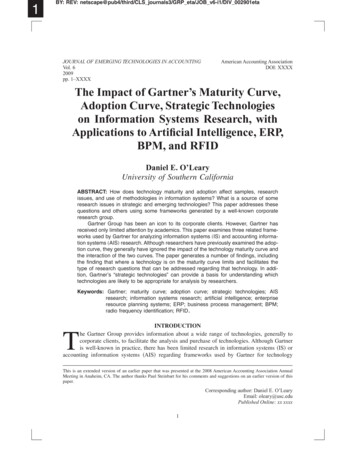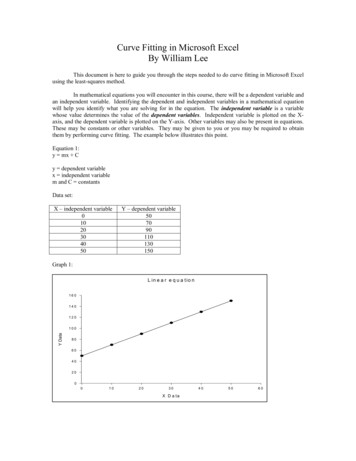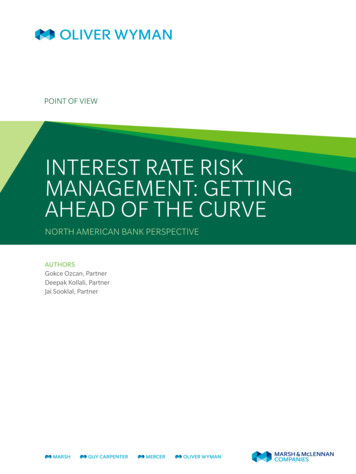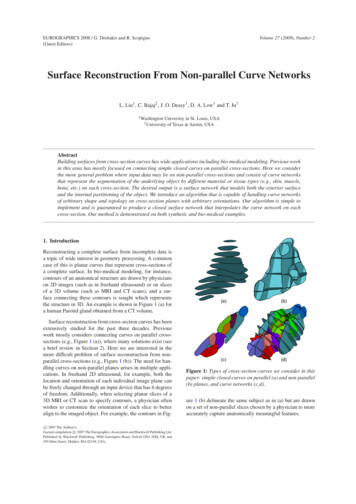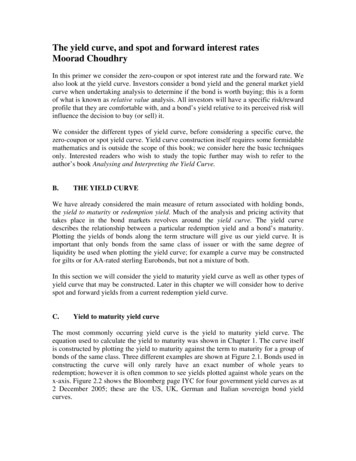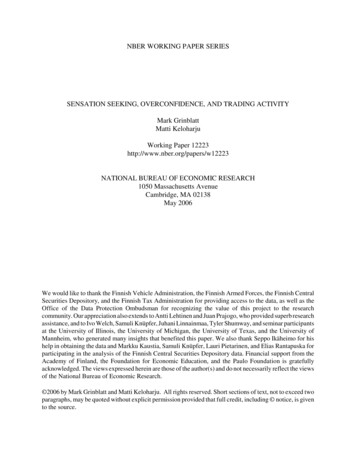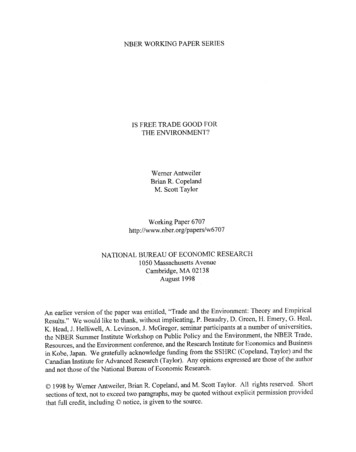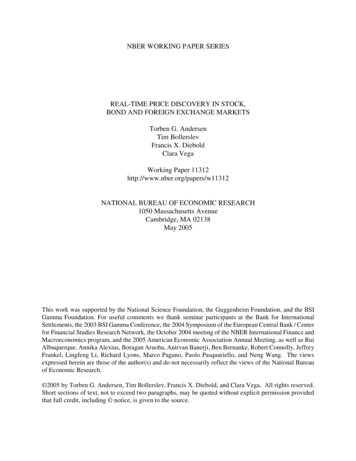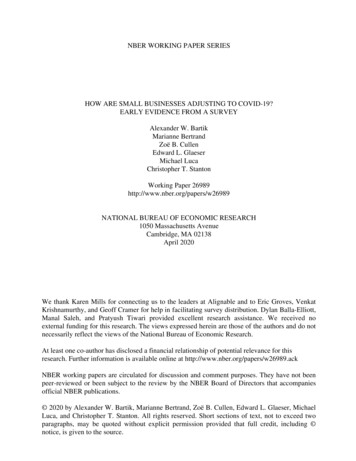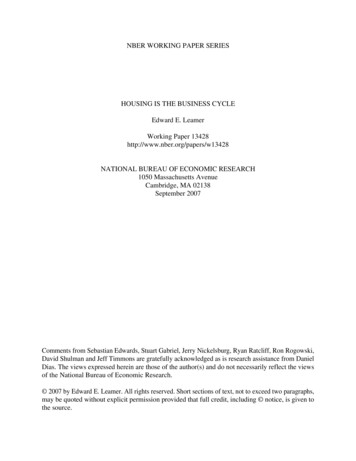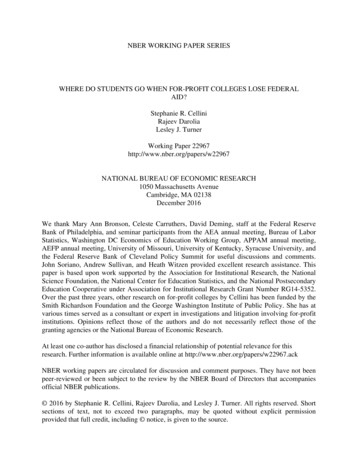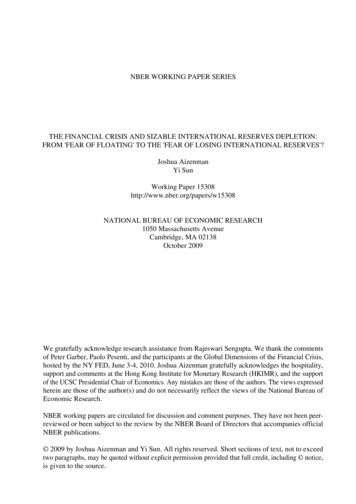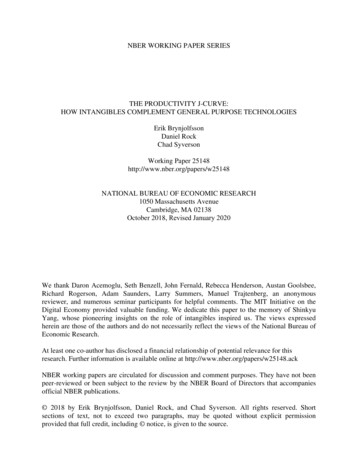
Transcription
NBER WORKING PAPER SERIESTHE PRODUCTIVITY J-CURVE:HOW INTANGIBLES COMPLEMENT GENERAL PURPOSE TECHNOLOGIESErik BrynjolfssonDaniel RockChad SyversonWorking Paper 25148http://www.nber.org/papers/w25148NATIONAL BUREAU OF ECONOMIC RESEARCH1050 Massachusetts AvenueCambridge, MA 02138October 2018, Revised January 2020We thank Daron Acemoglu, Seth Benzell, John Fernald, Rebecca Henderson, Austan Goolsbee,Richard Rogerson, Adam Saunders, Larry Summers, Manuel Trajtenberg, an anonymousreviewer, and numerous seminar participants for helpful comments. The MIT Initiative on theDigital Economy provided valuable funding. We dedicate this paper to the memory of ShinkyuYang, whose pioneering insights on the role of intangibles inspired us. The views expressedherein are those of the authors and do not necessarily reflect the views of the National Bureau ofEconomic Research.At least one co-author has disclosed a financial relationship of potential relevance for thisresearch. Further information is available online at http://www.nber.org/papers/w25148.ackNBER working papers are circulated for discussion and comment purposes. They have not beenpeer-reviewed or been subject to the review by the NBER Board of Directors that accompaniesofficial NBER publications. 2018 by Erik Brynjolfsson, Daniel Rock, and Chad Syverson. All rights reserved. Shortsections of text, not to exceed two paragraphs, may be quoted without explicit permissionprovided that full credit, including notice, is given to the source.
The Productivity J-Curve: How Intangibles Complement General Purpose TechnologiesErik Brynjolfsson, Daniel Rock, and Chad SyversonNBER Working Paper No. 25148October 2018, Revised January 2020JEL No. D2,E01,E22,O3ABSTRACTGeneral purpose technologies (GPTs) such as AI enable and require significant complementaryinvestments, including co-invention of new processes, products, business models and humancapital. These complementary investments are often intangible and poorly measured in thenational accounts, even when they create valuable assets for the firm. We develop a model thatshows how this leads to an underestimation of productivity growth in the early years of a newGPT, and how later, when the benefits of intangible investments are harvested, productivitygrowth will be overestimated. Our model generates a Productivity J-Curve that can explain theproductivity slowdowns often accompanying the advent of GPTs, as well as the increase inproductivity later. We use our model to analyze empirically the historical roles of intangibles tiedto R&D, software, and computer hardware. We find substantial and ongoing Productivity J-Curveeffects for software in particular and computer hardware to a lesser extent. Our adjusted measureTFP is 11.3% higher than official measures at the end of 2004, and 15.9% higher than officialmeasures at the end of 2017. We then assess how AI-related intangible capital may be currentlyaffecting measured productivity and find the effects are small but growing.Erik BrynjolfssonMIT Sloan School of Management100 Main Street, E62-414Cambridge, MA 02142and NBERerikb@mit.eduDaniel RockMIT Sloan School of Management100 Main Street, E62-412Cambridge, MA 02142drock@mit.eduChad SyversonUniversity of ChicagoBooth School of Business5807 S. Woodlawn Ave.Chicago, IL 60637and NBERchad.syverson@chicagobooth.edu
After I left academe in 2014, I joined the technical organization at iRobot. I quickly learned how challenging it is tobuild deliberative robotic systems exposed to millions of individual homes. In contrast, the research results presented inpapers (including mine) were mostly linked to a handful of environments that served as a proof of concept.-Alexander Kleiner 1I. IntroductionRobert Solow (1987) pointed out that “a technological revolution, a drastic change in ourproductive lives” had curiously been accompanied by “a slowing-down of productivity growth, notby a step up.” His famous productivity paradox, that one “can see the computer age everywhere butin the productivity statistics,” named a challenge for economists seeking to reconcile the emergenceof exciting technological breakthroughs with tepid productivity growth (Brynjolfsson 1993).Solow’s Paradox was not unique. In this paper, we argue it was one example of a moregeneral phenomenon resulting from the need for intangible investments in early stages of newgeneral purpose technologies. General purpose technologies (GPTs) are “engines for growth.”Specifically, they are pervasive, improve over time, and lead to complementary innovation(Bresnahan and Trajtenberg 1995). However, along with installing more easily measured items likenew types of physical equipment and structures, we emphasize that realizing their potential alsorequires large intangible investments and a fundamental rethinking of the organization of productionitself. Firms must create new business processes, develop managerial experience, train workers,patch software, and build other intangibles. This raises productivity measurement issues becauseintangible investments are not readily tallied on a balance sheet or in the national accounts.1Kleiner, Alexander. 2018. “The Low-Cost Evolution of AI in Domestic Floor Cleaning Robots” AIMagazine, (Summer).2
The presence and timing of this sort of intangible investment is one reason why Solow’sParadox could occur. When a new GPT emerges, there will be a period, possibly of considerablelength, during which measurable resources are committed, and measurable output forgone, tobuilding new, unmeasured inputs that complement the GPT. 2 For example, the technologies drivingthe British industrial revolution led to “Engels’ Pause,” a half-century-long period of capitalaccumulation, industrial innovation, and wage stagnation (Allen 2009; Acemoglu and Robinson2013). In the later GPT case of electrification, it took a generation for the nature of factory layoutsto be re-invented in order to fully harness the new technology’s benefits (David 1990). Solowhighlighted a similar phenomenon roughly two decades into the IT era.We call the measurement aspect of this phenomenon the Productivity J-Curve. As firms adopt anew GPT, total factor productivity growth will initially be underestimated because capital and laborare used to accumulate unmeasured intangible capital stocks. Later, measured productivity growthoverestimates true productivity growth because the capital service flows from those hiddenintangible stocks generates measurable output. The error in measured total factor productivitygrowth therefore follows a J-curve shape, initially dipping while the investment rate in unmeasuredcapital is larger than the investment rate in other types of capital, then rising as growing intangiblestocks begin to contribute to measured production. In the long run, as intangible investments andcapital stocks reach their steady-state growth rates, the return-adjusted value of the unmeasuredintangible capital stock service flows (in expectation) approaches the value of the initial unmeasuredinvestment. This means that some of the mismeasurement effects on productivity growth can persisteven in the long run.In Hornstein and Krusell (1996) and Greenwood and Yorukoglu (1997), the key intangibles are the skills andknowledge required to put new GPT-related capital to use, and these investments are made over a “learning” period.23
In our more general discussion of the current productivity paradox in the context ofArtificial Intelligence (AI) in Brynjolfsson, Rock, and Syverson (2019), we explained the basic idea ofthe Productivity J-Curve, building on earlier work by Yang and Brynjolfsson (2001). This paperformalizes and expands on this concept and provides a set of quantitative methods designed tomeasure the productivity effects of intangible investments. Namely, we augment a traditional growthaccounting framework to include intangible capital, deriving an expression for productivitymismeasurement as a function of the growth rates, size, and shadow values of intangible capital.Next, following Hall (2001 and 2004), Yang and Brynjolfsson (2001), and Hall (2006), we use a setof measures derived from stock market valuations to obtain measures of these intangible values. Thebasic idea of this approach is that market valuations reflect the value of intangibles even if they areotherwise hidden on firms’ balance sheets. We then use these measures of implied intangibles tocompute productivity growth mismeasurement associated with a four technologies: generic R&Dinvestments, computer hardware, software, and more speculatively, AI.II. Technology, Investment Theory, and Productivity GrowthEconomic historians have emphasized the transformative effects of GPTs. We mentionedthe work of David (1990), Allen (2009), and Acemoglu and Robinson (2013) above. Rosenberg andTrajtenberg (2004) identify the Corliss steam engine as an “icon of the Industrial Revolution,”shifting population centers from rural to urban areas as water power was abandoned in favor ofsteam. Crafts (2004) explores the contribution of steam power to growth for the British economyduring the Industrial Revolution. Lipsey, Carlaw, and Bekar (2006) offer a list of possible GPTs(including electrification, mass production, and the factory system) while relating those inventions tothe presence of a productivity paradox. Bresnahan (2010) conducts a wide review of the GPTconcept, making the point that the information and communication technologies (ICTs) of the4
modern era broadly constitute a GPT. Particularly relevant to our analysis is Helpman andTrajtenberg (1994), which notes how GPTs can generate alternating periods of investment andharvesting. Likewise, Jacobs and Nahuis (2002) suggest that GPTs can cause an initial productivityslowdown as high-skilled workers invest in knowledge instead of production.An important motivation for our analysis is the most recent potential GPT, artificialintelligence (AI). AI, and in particular the subfield of AI called machine learning, is pervasive,improves over time, and spawns complementary innovation, thereby meeting Bresnahan andTrajtenberg’s (1995) three canonical GPT criteria. Accordingly, after an implementation lag period,AI might significantly impact economic growth as other GPTs have (Aghion, Jones, and Jones 2017;Agrawal, McHale, and Oettl 2018; Cockburn, Henderson, and Stern 2018; Trajtenberg 2018;Brynjolfsson, Rock, and Syverson 2019). That said, the formal arguments presented here areapplicable to other technologies and intangible capital accumulation more generally. Indeed, weempirically apply the approach to investments in R&D, computer hardware, and software in recentdecades, generating a set of updated productivity series.Our approach applies Tobin’s q-theory of investment to infer productivity mismeasurementattributable to unmeasured intangible capital. We estimate the quantity of intangible investmentusing market value regressions where part of q is interpreted as reflecting intangible capital.Intuitively, when we observe a firm’s market value rise by an amount greater than observedinvestment, we infer the difference as reflecting the value of intangible capital investments that werecorrelated with the tangible investment. We call these intangible correlates. Our framework also handlesthe case in which intangible capital is used to produce more intangible capital.This approach has antecedents in the literature. Yang and Brynjolfsson (2001) note thatcombining q-theory of investment (Hayashi 1982; Wildasin 1984; Hayashi and Inoue 1991) andneoclassical growth accounting (Solow 1956; Solow 1957; Barro 1998; Corrado, Hulten, and Sichel5
2009; Oliner and Sichel 2000; Oliner, Sichel, and Stiroh 2008) can deal simultaneously with themagnitudes of the intangible component of GPT-related investment and implementation lags. Therecognition that q could reflect intangibles has led to numerous proposed updates to standardgrowth accounting frameworks and an emphasis in recent productivity studies on IT’s role inproductivity dynamics (Jorgenson and Stiroh 2000; Marrano, Haskel, and Wallis 2009; Corrado,Hulten, and Sichel 2009; McGrattan and Prescott 2010; Byrne, Fernald, and Reinsdorf 2016), andspecifically in the ICT-as-GPT case in (Basu, Fernald, Oulton, and Srinivasan 2003). 3The broader notion that intangibles might have a substantial role and growing role inproductivity and growth is not new. See, for example, Brynjolfsson and Hitt (2000); Hall (2000); Hall(2001); Brynjolfsson, Hitt, and Yang (2002); McGrattan and Prescott (2010); Tambe, Hitt, andBrynjolfsson (2012); Saunders and Brynjolfsson (2016) and McGrattan (2017). Haskel and Westlake(2017) summarize and evaluate many of the relevant arguments.The Productivity J-Curve that we describe in this paper is related to, but distinct from, thetrade balance J-curve of Magee (1973) and Rose and Yellen (1989). 4 Their J-curve describes howtrade balances react over time to changes in real exchange rates. 5 The similarity between the two Jcurves is that there is a change in the sign of derivatives of focal quantities with respect to time astime passes (trade balances in the earlier case, productivity in this one), reflecting the adjustment ofproduction processes in response to an external shock. In Rose and Yellen, the shock comes from alarge change in exchange rates. In our paper, it is from a large technological innovation.3We also note that the existence of significant intangible assets can explain the relatively poor historical performance ofTobin’s Q (the ratio of a firm’s market-to-book value) in explaining capital investment (Crouzet and Eberly 2018).Accounting for organizational investments, human capital, and business processes can strengthen the link betweenobserved investment and asset prices (Hall 2000; McGrattan and Prescott 2001; Eisfeldt and Papanikolaou 2013, 2014;Peters and Taylor 2017; Kogan et al. 2017; Andrei, Mann, and Moyen 2018).4 We tha
The Productivity J-Curve: How Intangibles Complement General Purpose Technologies Erik Brynjolfsson, Daniel Rock, and Chad Syverson NBER Working Paper No. 25148 October 2018, Revised January 2020 JEL No. D2,E01,E22,O3 ABSTRACT General purpose technologies (GPTs) such as AI enable and require significant complementary
